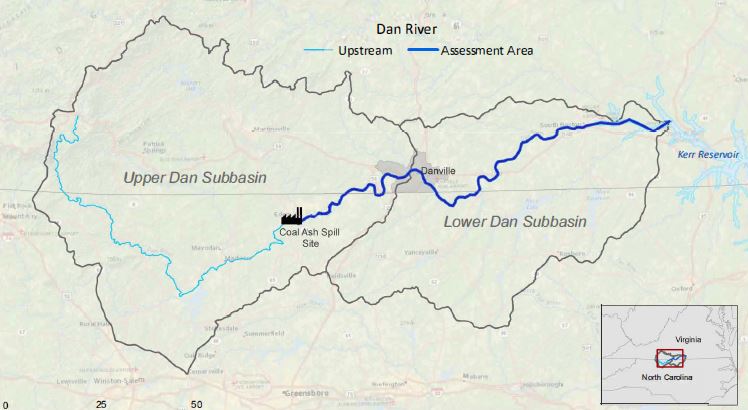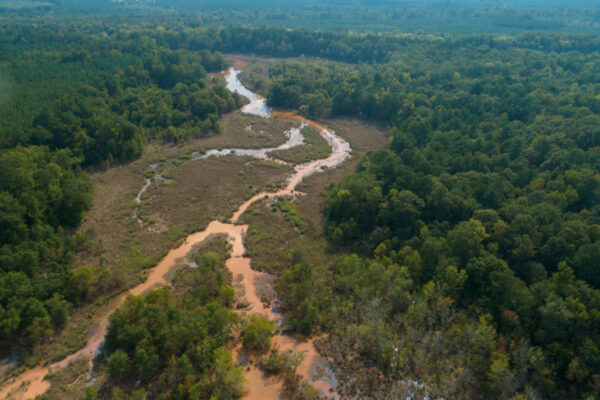This story has been updated with news regarding the purchase and transferal of the 64 acres by Duke Energy.
A settlement between Duke Energy and state and federal officials over the 2014 Dan River spill would impose no significant financial penalties, but it would preserve key tracts of land along the Mayo River, according to court documents.
Announced Friday, the agreement is between the utility and plaintiffs the US Fish and Wildlife Service, the NC Department of Environmental Quality and the Virginia Department of Environmental Quality.
In addition to Virginia projects, in North Carolina, Duke Energy would purchase up to 64 acres of floodplain and riverbank along the Mayo River and give it to state for conservation. The land would be added to Mayo River State Park in Mayodan, in Rockingham County. The cost of the acreage has yet to be determined. (Update: As of July 11, Duke Energy provided $363,000 to help Piedmont Land Conservancy acquire the land as part of early restoration activities conducted under the Natural Resource Damage Assessment and Restoration process, which is the basis for the settlement.)
The proposal will be subject to a 45-day public comment period. DEQ spokeswoman Laura Leonard said the public information meeting dates would be announced soon.
Conservation groups had unsuccessfully tried to buy the tracts from the private landowners because of disagreements about the price.
The agreement is one of several civil settlements and criminal penalties assessed against Duke Energy over the Dan River coal ash spill. On February 2, 2014, a stormwater pipe underneath the primary coal ash basin at the Dan River Steam Station near Eden failed, spilling 27 million gallons of coal ash wastewater and between 30,000 and 39,000 tons of coal ash into the Dan River.
Monitoring and sampling indicated that concentrations of hazardous substances, such as arsenic, lead, copper, selenium, and zinc, in surface water and river sediment were high enough to harm fish and other aquatic life.
Between Dan River Steam Station and its headwaters at Kerr Lake — nearly 100 miles away — a coal ash bar formed that was 75 feet long and 15 feet wide and contained five feet of ash or ash/sand mix.
Federal and state environmental officials collected and reviewed monitoring data in the Dan River for several years after the cleanup. During that time, they also gathered public input on potential restoration projects in the watershed that would equal the damages that occurred as a result of the contamination.
During the initial scoping phase in 2014, the public, including environmental groups, recommended 30 restoration projects along the North Carolina
portion of the Dan River and its tributaries. Of those, 68 members of the public, the Town of Mayodan, Piedmont Land Conservancy, the Conservation Fund and other groups recommended expansions and improvements to Mayo State Park,according to public documents.
A USFWS summary noted the Mayo improvements “meet the all criteria identified by the Trustees for a good restoration project to address the injuries caused by the spill.”
The land conservation is expected to increase quality and quantity of habitat, connect with other natural areas and create new recreational benefits within the Dan River watershed.
The Mayo River joins the Dan River upstream of the Duke Energy spill site. It serves as habitat for many endangered and rare species, including the James Spinymussel and Roanoke Logperch.
Although it took five years to reach the settlement, that is not considered a long time for damage assessments to natural resources, USFWS spokesman Phil Kloer told Policy Watch.
“The coal ash spill was a unique event,” Kloer said. “It takes time to assess the damage of such an event on the natural resources, animals and vegetation.”
The consent decree resolving natural resource damage liabilities for the Yellowstone River Oil Spill, which occurred July 1, 2011, was entered by the court on December 12, 2016. Unlike the Dan River spill, there was no restoration in the Yellowstone case before the final settlement.
“The timing of the [Dan River] settlement did not delay the restoration of natural resources and recreational services,” Kloer said.
In addition to projects in Virginia, Duke Energy had previously funded the acquisition of 340 acres near the river and transferred the title to North Carolina State Parks.
In 2015, the EPA fined Duke Energy $68 million in criminal penalties, plus a $24 million community service payment to the National Fish and Wildlife Foundation to benefit the ecosystems of North Carolina and Virginia. Duke was also required to provide $10 million to a mitigation bank for the purchase of wetlands or riparian buffers to offset the long-term environmental damage. DEQ fined Duke an additional $6 million.
The company’s probation period ends within the next year.
Paul Draovitch, Duke Energy vice president for environment, health and safety, told the Associated Press that “these environmental projects conserve important land, improve aquatic habitat and allow more community access to nature and the outdoors.”







